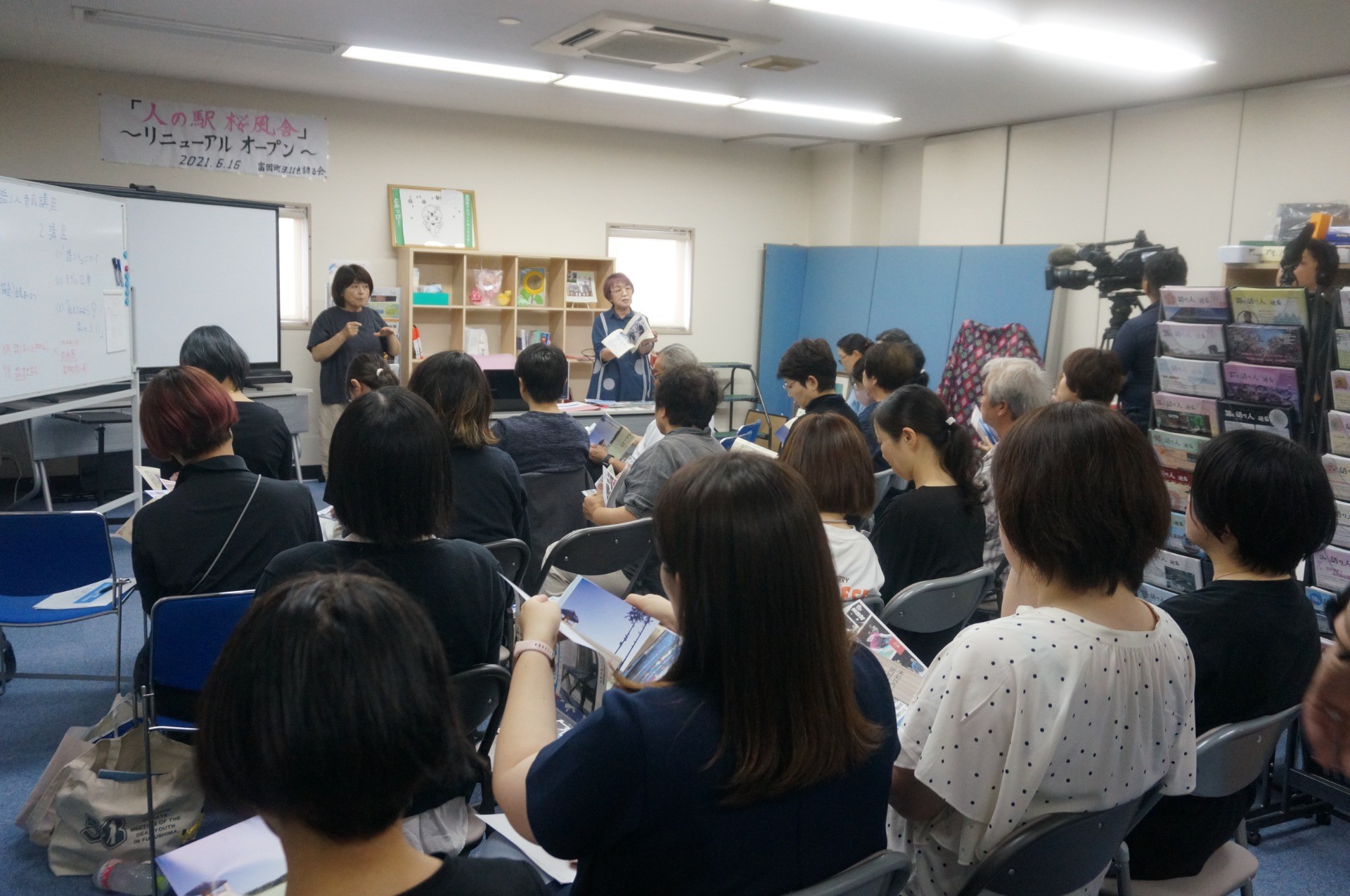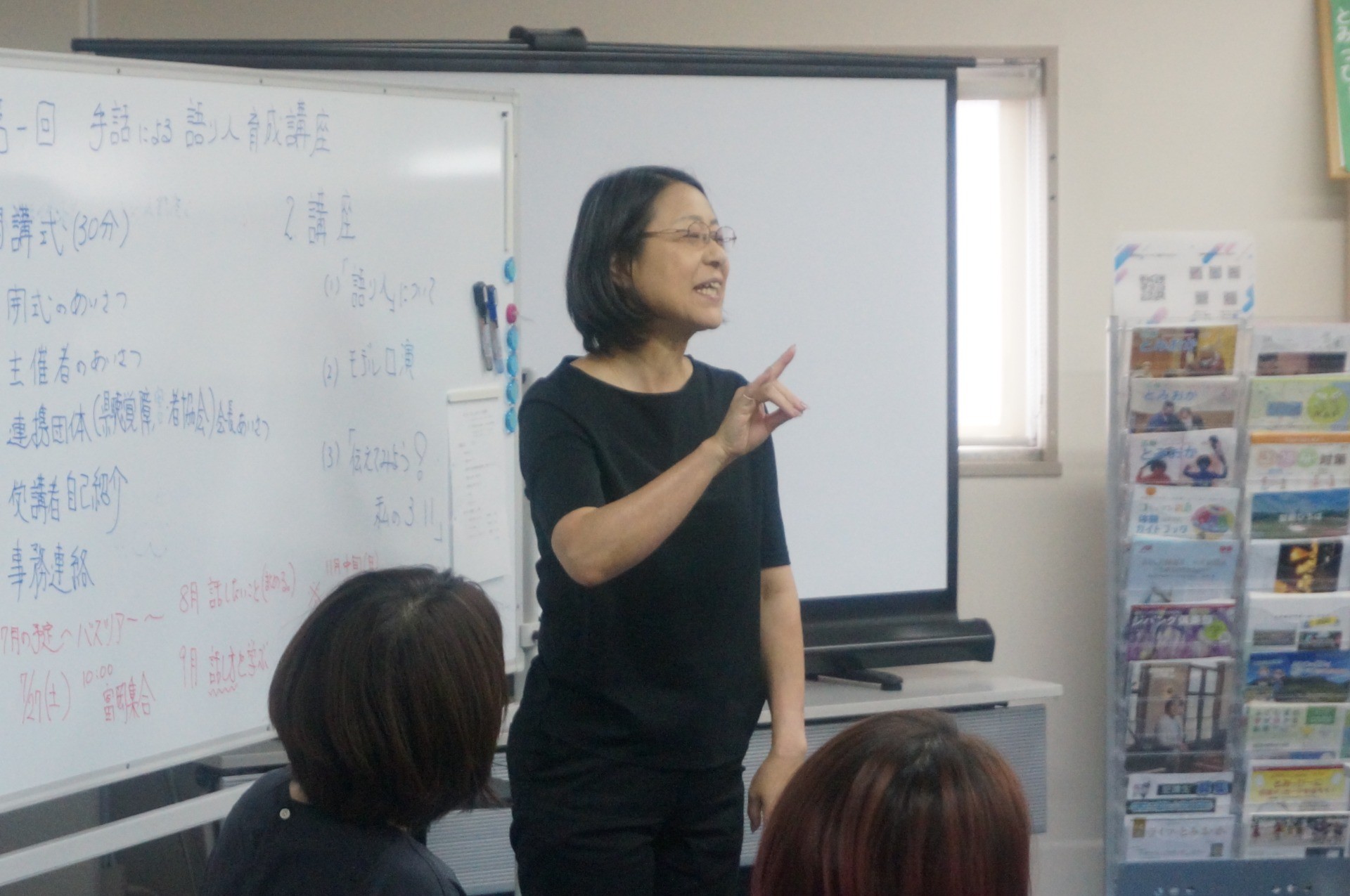Latest News
Storyteller Training with Sign Language - Lessons Learned from the Nuclear Disasters
On June 30, the Kataribe (Storyteller) Training Course began in Fukushima Prefecture to convey the lessons of the 2011 Great East Japan Earthquake and the Fukushima Daiichi Nuclear Disaster in sign language. The training was sponsored by Tomioka Town 3/11, a local organization Civic Force collaborates with in the NPO Partner Project. The 25 participants included people with hearing impairments and sign language interpreters. Ms. Yoshiko Aoki shared why she started the sign language training course, the content of the course, and the current situation in Fukushima.
Q. Please tell us about the background and motivation behind starting the “Kataribe” training course in sign language.

I continue to work as a kataribe to convey the situation in Tomioka Town, Futaba District, where the entire town was forced to evacuate. In addition to telling about the reality of long-term evacuation life, working toward recovery, and the issues faced by the town, we have also focused on efforts to cultivate storytellers across generations to prevent the stories from fading.
The reason we started the Kataribe training course in sign language was to realize the goal of disaster preparedness which is to leave no one behind.' After 3.11, many people, including myself, have continued to carry out Kataribe activities in our own styles, but as of now, there is no one in the prefecture who is using sign language.
At the Nuclear Disaster History Museum built in Futaba Town, subtitles have recently been added to audio guidance. The Prefectural Association for the Hearing Impaired has been receiving requests to bring in storytellers who can sign and we cooperated with the association from an early stage in this recruitment process.
Q.What did you cover during the training on June 30 and how was it received?

We received more applications than we could accommodate and a total of 25 people participated. We began sharing what kataribe is and discussed the importance of conveying the story while capturing the interest of the listener. At the end, each participant shared their own experience.
A participant said that it's embarrassing as a Fukushima citizen to not have had the opportunity to learn more about the nuclear accident until now. Participants want to share about earthquakes and nuclear power plants with their children. Some evacuees who live far away from the coastal towns have spent 13 years without knowing much about the nuclear accident, even though they are residents of the same prefecture.
Seeing the participants communicating in sign language made me realize the great potential of sign language. Sign language conveys information through body movements without the need for audible information, giving it a sense of realism. I am convinced that if we can make use of this attractive expression it will lead to wonderful storytelling activities.
Q.The course is planned to run through the fall. What are your plans for the future?

We are planning on having four trainings in Fukushima City, Tomioka Town, and more by October, and will be presented at Tomioka Town's "Storytelling Festival" in November.
The participants will receive further training and join the Prefectural Association for the Hearing Impaired. We aim to create a system in which these storytellers can be dispatched to various locations upon request.
Q. More than 13 years have passed since the Great East Japan Earthquake. The Fukushima nuclear power plant accident is an issue for all of Japan. How can we effectively communicate about these challenges?
The accident ruined many people’s lives - people lost their families, their jobs because they could no longer live in their familiar places, and some died of disaster-related deaths. I believe that everyone should take part in sharing the lessons learned from the disasters in order to prevent such an accident from happening again.
Our aim is not to look back on the past like a worn-out record, but to communicate the current situation of the region, which continues to face the challenges of the nuclear power plant accident, and to think together about the state of energy and society in Japan. There is a need for a place where anyone interested in the disaster-stricken areas can learn lessons and gain knowledge to prepare for future disasters.
Lastly, the driving force behind Fukushima's recovery is to restore the human connections that were taken away and to revitalize new communities. I want to create opportunities for everyone to connect, transcending regions and generations.

Yoshiko Aoki’s Profile:
Ms. Aoki was born in Tokyo and now resides in Tomioka Town, Fukushima. She taught Japanese language at a public high school in Fukushima from 1970 to 2008. She was deeply involved with Tomioka Town since she was a principal at Tomioka High School. In 2015, she launched Tomioka Town 3/11 to promote storytelling.

-
Great East Japan Earthquake
Donate to this project
Bank Transfer
SUMITOMO MITSUI BANKING CORPORATION(SWIFT code:SMBCJPJT)
Aoyama Branch (Branch No. 258)
5-9-12, Minamiaoyama, Minato-ku, Tokyo, 107-0062, JapanACCOUNT NAME CIVIC FORCE
ACCOUNT NO.6953964
TomigayaOgawa Bldg.2F, 2-41-12 Tomigaya, Shibuya-ku, Tokyo, 151-0063, Japan*The account holder's names for the banks are "Civic Force" or "公益社団法人Civic Force シャ)シビックフォース".
**Please note that 15% of your donation will be allocated to general operating expenses.
Latest News
-
News
【Media】 7/8 - Civic Force Featured in EnGift Web
-
Create emergency preparedness mechanism
Stockpiling Relief Supplies with Takeo City in Preparation for Disasters
-
News
【Noto Peninsula Earthquake】 NPO Partner Project - Free Transportation Service
-
News
Civic Force at Policy Study Group with the Governor of Ishikawa Prefecture
Category
Tag







